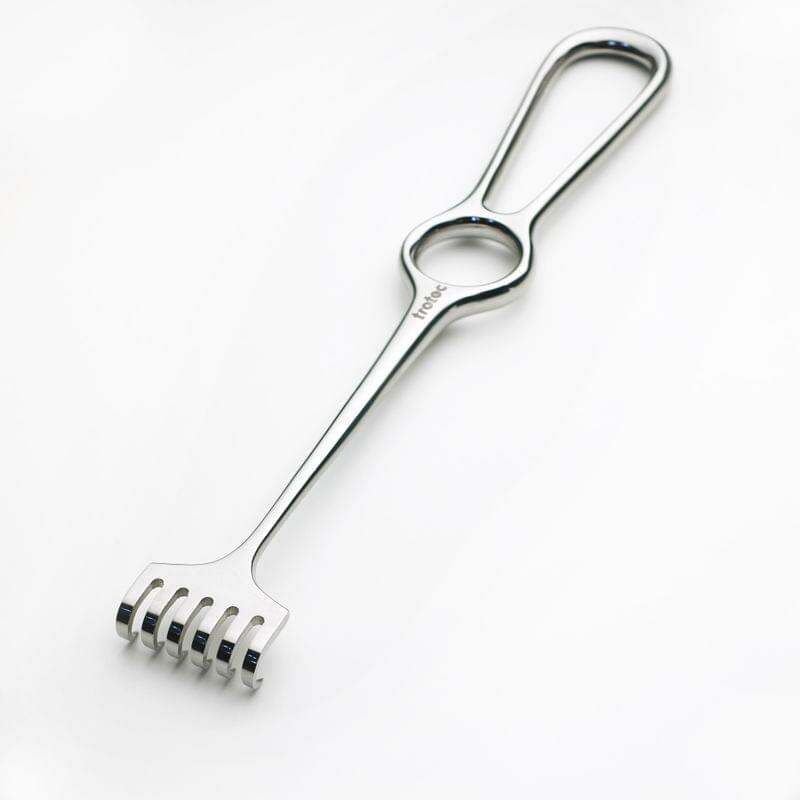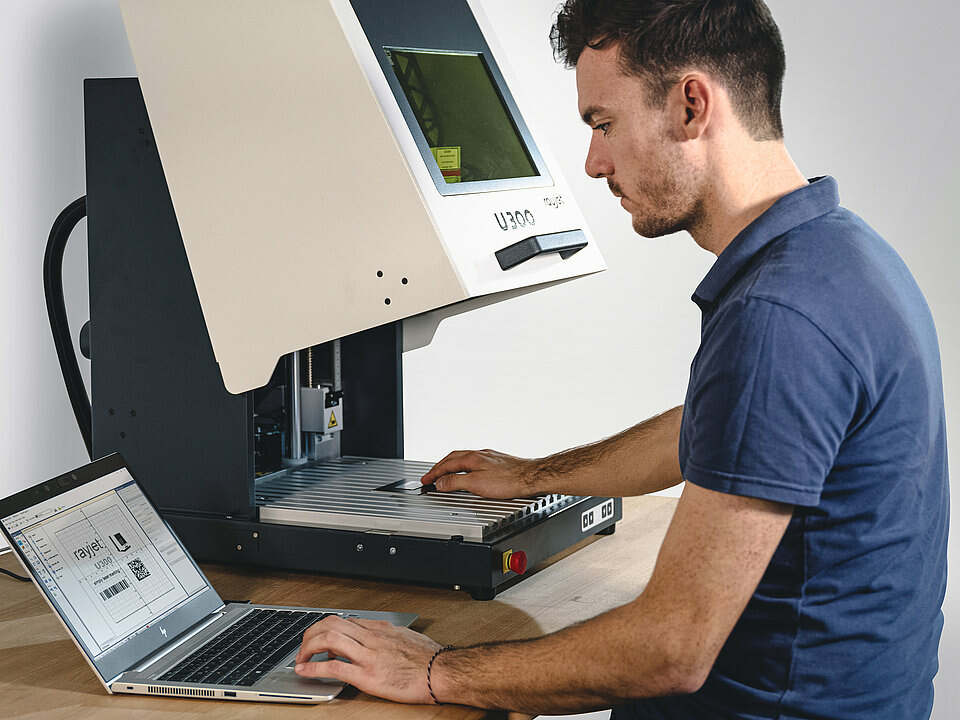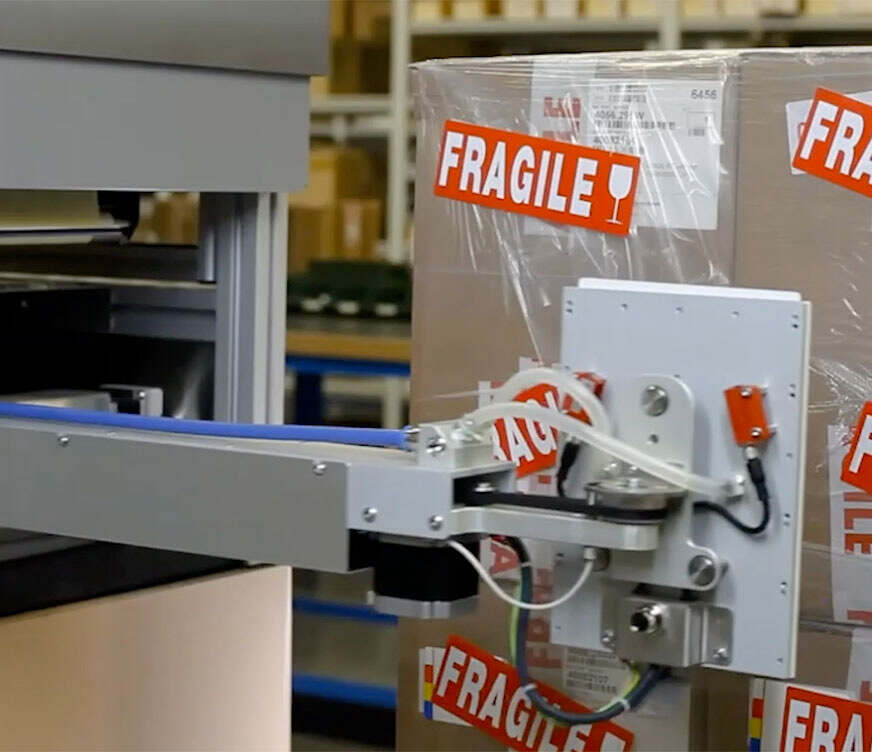Laser engraving in metal - everything you need to know about modern label

Table of contents
Laser engraving in metal has become an indispensable technology in many industries, from industry and medicine to design and consumer products. With high precision, durability and flexibility, laser engraving offers the opportunity to create everything from detailed designs and logos to traceability codes and permanent markings. In this article, we explore how technology works, its history, benefits and the broad uses that have made it a revolutionary solution for metalworking.
Engraving metal - from crafts to modern laser technology
Engraving and labeling metal is a technology that has developed over thousands of years and has played an important role in human history.
Early methods
- Craft tools: The very first marks on metal were made with the help of simple tools such as hammer, burial stitch and chisel. You beat or cut in hand simple patterns or symbols in the metal.
- Etching: Later, the technology was developed to use acids to "etch" designs on metal surfaces. This method was used, among other things, to create decorative objects and to mark possessions.
The influence of industrialization
- Mechanical engraving tools: With industrialization came more advanced mechanical tools for engraving. These machines made it possible to create more detailed and repeatable patterns.
- Stamping: Stamps with raised designs were used to quickly and effectively notice large amounts of metal products.
Modern technology
- Laser Technology: The largest revolution in engraving and labeling came with the development of laser technology during the second half of the 20th century. Lasers made it possible to create extremely precise and detailed labels on a variety of metals.
- Computer control: Computers revolutionized the design process and made it possible to create complex designs that could then be transmitted directly to laser machines.
| Method | Advantages | Disadvantages |
| Craft tool | High artistic freedom, very detailed patterns. | Time -consuming, requires great skill, limited to smaller surfaces. |
| Chemical etching | Can create very detailed designs, enables large areas. | Time -consuming, requires the handling of dangerous chemicals, difficult to control the depth of etching. |
| Stamping | Fast and easy for large volumes, low cost per unit. | Limited detail, requires a stamp for each design. |
| Laser engraving | High precision, fast, flexible, sustainable, environmentally friendly. | Higher investment cost for equipment. |


What is laser engraving?
Laser engraving/labeling is a technology where you use a focused laser beam to remove material from the surface of an object and create a permanent label. This label can consist of text, logos, images or other design elements.
How does it work?
- The laser beam : a high -energy laser beam is focused on a very small point on the surface of the material.
- Material removal : When the laser beam hits the material, the material is removed either by evaporating or melting.
- Labeling : The area where the material has been removed forms a marking that is permanent and resistant to wear.
Read more about how a laser engraving machine works
Benefits of laser engraving
- High precision: Enables very detailed and accurate labels.
- Speed: The process is fast, especially for large volumes.
- Flexibility: Can be used on a variety of materials, including metals, plastic, wood and glass.
- Sustainability: The markings are very durable and resistant to wear and weather.
- Environmentally friendly: The process is relatively environmentally friendly as it does not require any chemicals or large amounts of energy.
A versatile technology with countless uses
Laser engraving in metal has become an increasingly common technology in the industry and has revolutionized how we notice and adapt metal products. Its precision, durability and flexibility make it an invaluable tool in a variety of industries.
Industrial applications
- Manufacturing:
- Labeling of components: serial numbers, traceability codes, logos and other identification labels on everything from small electronic components to large industrial machines.
- Tool manufacturing: Engraving tools to identify them and to create specific designs.
- Form production: Creation of complex patterns and structures on molds for casting and pressing.
- Automotive:
- Car parts: labeling engine blocks, gearboxes and other car parts with manufacturing information and logos.
- Car chassis: engraving of chassis numbers and other identification labels.


Medical industry
- Implants: Labeling of implants with patient information and other relevant data.
- Surgical instruments: engraving instruments for identification and sterilization.
- Orthopedic products: labeling of prostheses and other orthopedic products.


Jewelery industry
- Jewelry: Personal engravings on rings, necklaces and bracelets.
- Urar: engraving logos, serial numbers and personal messages on dials and rear pieces.


Architecture and design
- Metal structures: engraving of metal panels, facades and sculptures with decorative patterns or logos.
- Interior: engraving of furniture, lighting and other interior details.
Military and defense
- Weapon: Labeling of weapons with serial numbers and other identification information.
- Equipment: Engraving equipment to mark the owner and unit.
Other industries
- Aerospace: Labeling of components in the aviation and space industry.
- Sports equipment: engraving personal messages on sports equipment.
- Consumer products: engraving of logos and designs on different types of products.


Different types of laser machines for metalworking
Laser machines have revolutionized the manufacturing industry through its precision and flexibility. But the type of laser machine that is best suited depends on the material to be processed and the specific application. Let's take a closer look at some of the most common types.
1. Fiber laser
- Function: The fiber laser uses an optical fiber to transfer the laser beam and generates a highly focused beam with high power.
- Material: For example, stainless steel, carbon steel, aluminum and other metals.
- Benefits: High efficiency, long life, high precision and can cut thick materials.
- Disadvantages: Higher investment cost than the CO2 laser.

2. Diode laser
- Function: The diode laser is a semiconductor laser that generates an infrared laser beam.
- Material: Often used for labeling and engraving of metals, plastic and certain types of ceramics.
- Benefits: Compact, cost -effective, low energy consumption.
- Disadvantages: lower power than CO2 and fiber laser, limited cutting capacity.
3. ND: Yag-laser
- Function: ND: YAG-laser uses a neodym-doped Yuttriumaluminum Granate crystal as a laser medium.
- Material: Used for both metals and non-metals, including difficult-to-work materials such as ceramics and glass.
- Benefits: High top power, good for welding and drilling.
- Disadvantages: Higher operating costs compared to CO2 and fiber laser.

4. UV laser
- Function: The UV laser generates an ultraviolet laser beam with very short wavelength. When the beam hits the material, a photochemical reaction occurs that changes the material's surface at the molecular level.
- Material: Excellent for a variety of materials, including plastic, glass, metals, ceramics, and some types of rubber.
- Benefits: High resolution, low heat impact on the material, versatile, environmentally friendly.
- Disadvantages: lower power than other laser types, higher investment costs.
Read more about our UV-laser Linx UVG5 which is perfect for the production industry
Laser parameters: the key to a perfect result
Laser parameters are settings that control the laser's behavior and thus directly affect the result of your engraving or cutting. Understanding and being able to adjust these parameters is crucial to achieving the desired quality and efficiency.
Important laser parameters and their influence
- Effect: This is the strength of the laser. Higher power gives more energy, which is necessary to cut thicker materials or create deep engravings. However, an excessive power can lead to burn marks or the material melts.
- Speed: The speed determines how quickly the laser head moves over the material. Higher speed provides less time for the laser to affect the material, which can result in a superficial engraving. An excessive speed can cause excessive heating and damage to the material.
- PPI (pulses per inch): This value determines how many laser pulses are applied per inch. Higher PPI provides a finer detail, but can also increase the processing time.
- Frequency: Measures the number of laser pulses per second. Higher frequency gives more continuous effect, which can be good for cutting some materials.
- Passport: indicates the number of times the laser goes over the same area. Several passes can increase the depth of an engraving or cutting.
- Focus: Focus mode affects how the laser beam hits the material. For deep penetration, a focus is often required below the material surface.
- Assist gas: Many laser machines use an assist gas, e.g. Air or nitrogen, to cool the workpiece, remove molten material and improve cutting quality.
How the parameters affect the result
- Engraving:
- High power, low speed, high PPI: depth and detailed engraving.
- Low power, high speed, low PPI: superficial engraving with less detail richness.
- Cutting:
- High power, low speed: Fast and clean cutting of thick materials.
- Low power, high speed: Fine cut with less taper.
To find the right parameters
Finding the optimal parameters of a specific material and a particular application can be a challenge. Here are some tips:
- Start with the material's data sheet: many manufacturers of laser machines offer databases with recommended parameters for different materials.
- Do test runs: start with low power and speed settings and gradually increase until you get the desired result.
- Be systematic: Change only one parameter at a time to see its impact.
- Document your results: Track which parameters give the best results for different materials.
Common metals for laser engraving and their reaction to laser radiation
Laser engraving of metal is a precision process used to create permanent markings, patterns and details on a variety of metals. How a metal reacts to laser radiation depends on its composition and properties.
Common metals for laser engraving:
- Stainless steel: one of the most common metals for laser engraving. Stainless steel reacts well to laser radiation and gives a dark, contrasting marking. There are different degrees of stainless steel, and each degree can have a slightly different reaction to the laser.
- Aluminum: Aluminum is a light and malleable material that is also popular for laser engraving. When aluminum is exposed to laser radiation, the superficial layer melts, resulting in a matte, contrasting label.
- Copper: Copper is a soft metal with high thermal conductivity. Laser engraving of copper often results in a brown or black labeling, depending on the laser settings.
- Brass: Brass is an alloy of copper and zinc. It reacts well to laser engraving and provides a contrasting marking.
- Titanic: Titanic is a strong and light metal used in many industries. It is resistant to corrosion and heat, making it ideal for laser engraving. Laser engraving of titanium often results in a blue or golden label.
- Gold and silver: precious metals such as gold and silver can also be laser engraved. Engraving these metals often requires lower power settings to avoid digging the metal.
Trotec: A leading player in laser technology
Trotec is a global company that specializes in innovative laser technology. They are known for their high quality laser graves , laser cutters and laser brand machines . Since its inception, the company has been a pioneer in the industry and has continuously developed new solutions to meet customer needs.
Why is Trotec leading?
- Innovative technology: Trotec is at the forefront when it comes to the development of new laser technology. They are constantly investing in research and development to create more efficient and precise laser machines.
- Wide product range: Trotec offers a wide range of laser machines that are suitable for a variety of applications and materials.
- High quality: Trotec's machines are known for their high quality and reliability.
- Global Presence: With a large network of retailers and service centers around the world, Trotec can offer support and service to customers all over the world.
- Complete solutions: In addition to machines, Trotec also offers a wide range of accessories, software and materials to ensure that customers have everything they need to succeed in their projects.
Trotec's history
Trotec has its roots in the Austrian company Trodat, which is the world's largest manufacturer of stamps. Trotec was founded with the goal of developing and manufacturing innovative laser machines. Today, Trotec is an independent unit within Trogroup and one of the world's leading manufacturers of laser machines.
Trotec's range for metal engraving and labeling
Trotec offers a wide range of laser machines specialized for engraving and marking of metal, but not cutting. Each series has its unique properties and is adapted for different types of applications. Let's take a closer look at the Speedy FlexX series, U-series and the Speedmarker series.
Speedy FlexX series: The versatile allrounder
The Speedy FlexX series is a hybrid solution that combines both CO2 and fiber laser technology in a single machine. This makes it extremely versatile and capable of processing both non-metals and metals.
- Advantages:
- Flexibility: Thanks to both CO2 and fiber laser, you can cut and engrave a wide range of materials, from wood and plastic to metals (not cut) such as stainless steel and aluminum.
- Efficiency: You only need a machine for several different tasks, which saves both space and money.
- Precision: Both CO2 and fiber laser provide high precision and detail in your engraving and cuts.
- Applications:
- Prototype production
- Personal products
- Industrial applications
- Labeling of metals


U-series: High-performing fiber laser
The U-series is a series of high-performance fiber laser machines , especially designed for metal processing. They offer extremely high precision and speed and take up little space in the production space, making them ideal for industrial applications.
- Advantages:
- High speed: Fast and efficient processing of metals.
- High precision: Exact labeling and cutting with nice details.
- Low operating cost: Low energy consumption and long service life on the Laser source.
- Applications:
- Labeling of components
- Serial number
- Logos


Speedmarker series: Compact and flexible
The Speedmarker series is compact and flexible fiber lasers , perfect for labeling smaller workpieces. They are easy to integrate into existing production processes and offer high speed and precision.
- Advantages:
- Compact design: Easy to place in different environments.
- High speed: Fast labeling of large volumes.
- Flexibility: Can be used for both desktop and mobile labeling.
- Applications:
- Marking of machine and electronics components
- Medical implants
- Tool
- Small metal parts such as signs

Trotec Ruby: A new era within Lasersoftware
What is Ruby?
Ruby is Trotec's latest and most advanced lasersoftware. It is a whole new generation of software designed to do the work with laser machines both simpler and more efficient. Ruby takes you from idea to finished product in a smooth and intuitive way.
How does Ruby work?
Ruby is a cloud -based system that connects all your laser machines. It gives you the opportunity to:
- Design and prepare your jobs directly in Ruby: you no longer need to switch between different programs. Ruby has all the tools you need to create and edit your graphic files.
- Sending a job to any machine in your network: No matter where you are, you can send a job to your laser machines.
- Monitor your jobs in real time: Follow your jobs from start to finish and get notes when they are ready.
- Share files and settings with other users: easily collaborate with your colleagues.
- Take advantage of an extensive material database: gain access to a large number of preset parameters for different materials.
What features are in Ruby?
- Intuitive user interface: Ruby is easy to learn and use, even for beginners.
- Integrated graphics editing: Create and edit your graphic files directly in Ruby.
- Support for a large number of file formats: Import files in different formats, such as PDF, SVG, PNG, AI, etc.
- Advanced tools for vector graphics: Create complex designs and design.
- Automatic nesting: Optimize material use by automatically placing multiple items on the same sheet.
- Job management: Organizing and managing your jobs effectively.
- Cloud -based: Access to your jobs and settings wherever you are.
- Collaboration: Share files and settings with other users.


So our customers work with laser engraving of metal
Metal laser engraving has become a crucial technology for many of our customers who are looking for high precision, sustainable labeling and adapted solutions. The technology is used in a number of industries, from industrial production and crafts to art and design. Our customers use Trotec's advanced laser machines to label everything from small details to large components, which strengthens both production efficiency and product quality. Here we share inspiring examples of how our customers successfully use laser engraving to meet their unique needs.
Effective laser engraving strengthens Lesjöfors collaborations with industry
Lesjöfors Industrioneers Mönsterås AB has implemented laser engraving with Trotec Speedmarker 700 to meet Volvo's requirements for permanent labeling of metal products. The technology is used to label brands and article numbers on feathers and band details with high precision and efficiency. Laser engraving is now an important part of production and supports the company's growth and collaboration with large customers such as Volvo. Read more
Nordicenvoy grows with Trotec for higher quality and efficiency
Nordicenvoy AB invested in Trotec laser machines, including Speedy 100 and Speedy 400 FLEXX , to improve control over the quality of its products and streamline production. Laser engraving has enabled the company to customize brand exposure on materials such as metal, glass and wood, which has led to increased customer satisfaction and more assignments. The technology is used, among other things, to engrave ID plates and special design on glass art, which strengthens Nordicenvoy's position as a leading player in its segment. Read more







